|
|
|||
|
(Back to Preceding Week; on to Next Week) |
|
NOTHING'S SLOWER THAN A TURTLE Through the years, several of our photo essays have dealt with the fascinating assortment of turtles that do quite well at Hilton Pond Center, where some species can be seen sunning on pond banks even in midwinter. We've written about a hatchling Common Snapping Turtle we rescued as it crossed the a well-traveled road in front of the Center, about Yellowbelly Sliders who live up to their name by slipping into water at the slightest sign of danger, about Eastern Mud Turtles that prowl the murky depths, and--most recently--about Painted Turtles (below) that lumber onto land each spring to lay their leathery eggs.
All text & photos © Hilton Pond Center As if on cue, when we were writing our installment last year about Painted Turtles, Chrysemys picta, a mature female came ashore, made her way to the flat, grassless area just behind the Center's old farmhouse, and began excavating a nest hole (below) only a few feet from our office window. We got to watch and photograph the whole event.
Here's what we wrote back on 15-21 June 2008:
All text & photos © Hilton Pond Center After gently scooping up the turtlets and placing them in a glass bowl we pulled out all the vegetation to be sure we hadn't overlooked any hatchings. There were none to be found but we did locate the one-inch-diameter hole (below right) through which these newest additions to our turtle population had emerged. A newly hatched turtle often has a small, raw bump on its lower shell (below), a remnant of where the developing reptile's yolk sac was attached. Only one of our hatchlings bore such a scar but it seemed old, so this--along with the absence of empty eggshells--led us to speculate the new turtlets hatched late last autumn but stayed in the nest until weather warmed up this spring. Baby turtles are known to do just that, undoubtedly an adaptation that allows them to remain safe underground for months rather than running the risk of overwintering in cold--even freezing--pond water.
All text & photos © Hilton Pond Center After photographing the two little Painted Turtles we were in a slight quandary about what to do next. We thought about placing them in the small water gardens in the farmhouse side yard where we could watch them but ruled that out because they might be too easily captured by the pesky Raccoons that visit almost nightly. We did rule out the completely laissez-faire "natural" approach of just releasing them right where they had hatched because the nest was a good 75 yards from the water--quite a ways to travel for a little reptile barely the size of a 25-cent piece. In the end we simply carried the bowl and two turtlets to the edge of Hilton Pond and watched as instinct took over; they swam away and immediately dived for the relative safety of the dark bottom.
All text & photos © Hilton Pond Center We don't know if these two Painted Turtle youngsters will make it--there's a good chance they'll be consumed by a big fish or a small heron and maybe even another turtle looking for lunch--but we figured we might as well help out a little. It's the least we could do for two turtlets who, in typically slow turtle fashion, finally appeared ten months after their mother laid her eggs in warm June soil at Hilton Pond Center. All text & photos © Hilton Pond Center ADDENDUM: On 25 January 2000--the week before we posted our first This Week at Hilton Pond photo essay, we were running traps and caught 14 birds, including three Chipping Sparrows. On 17 April 2009 were were running essentially the same traps in the same locations and caught 30 new birds--and got one Chipping Sparrow that was already banded.
All text & photos © Hilton Pond Center A check of the chippie's band showed it was #2390-22239, a number we did not immediately recognize. That's because when we consulted our records we learned it was a bird we banded nine years ago; we simply don't remember all of the older band numbers we've used. At banding in 2000 we were unable to sex this bird--Chipping Sparrows are sexually monomorphic with males and females appearing similar--but we aged it then as an After Hatch Year bird that had to have be born no later than 1999. Based on this ageing convention, upon recapture in 2009 the Chipping Sparrow is After Tenth Year--making it the oldest bird we've ever had at Hilton Pond Center. (We still don't know its sex.) Despite its advanced age, this bird doesn't qualify as the oldest Chipping Sparrow in the federal Bird Banding Laboratory database--that honor goes to one age 11 years 10 months at its most recent recapture--but we're still very pleased to have renewed our acquantance with this Methuselah-bird we banded back in 2000 at the Center. All text & photos © Hilton Pond Center
Comments or questions about this week's installment?
Thanks to the following fine folks for recent gifts in support of Hilton Pond Center for Piedmont Natural History and/or Operation RubyThroat: The Hummingbird Project. Your tax-deductible contributions allow us to continue writing, photographing, and sharing "This Week at Hilton Pond." (Please see Support if you'd like to make a gift of your own. You can also contribute by ordering an Operation RubyThroat T-shirt.)
"This Week at Hilton Pond" is written & photographed You may wish to consult our Index of all nature topics covered since February 2000. You can also use our on-line Hilton Pond Search Engine at the bottom of this page. For a free, non-fattening, on-line subscription to |
|
Make direct donations on-line via
Network for Good: |
|
|
Use your PayPal account
to make direct donations: |
|
|
If you like to shop on-line, you please become a member of iGive, through which more than 750 on-line stores from Barnes & Noble to Lands' End will donate a percentage of your purchase price in support of Hilton Pond Center and Operation RubyThroat. For every new member who signs up and makes an on-line purchase iGive will donate an ADDITIONAL $5 to the Center. Please sign up by going to the iGive Web site; more than 200 members have signed up to help. It's a painless, important way for YOU to support our on-going work in conservation, education, and research. |
|
|
SPECIES BANDED THIS WEEK: * = New species for 2009 WEEKLY BANDING TOTAL 7 species 156 individuals YEARLY BANDING TOTAL (2009) 19 species 916 individuals 28-YEAR BANDING GRAND TOTAL (since 28 June 1982, during which time 170 species have been observed on or over the property) 124 species 52,798 individuals NOTABLE RECAPTURES THIS WEEK (with original banding date, sex, and current age) Chipping Sparrow (5) American Goldfinch (8) Northern Cardinal (2) House Finch (3)
|
OTHER NATURE NOTES OF INTEREST --Our most commonly captured birds at the Center include four "winter finches": House Finch (7,960 banded), American Goldfinch (7,654), Purple Finch (7,554), and Pine Siskin (1,768). With a rare incursion of siskins this winter--in conjunction with good numbers of goldfinches and Purple Finches--as of 21 Apr these four species comprised 47.23% of the 52,798 birds banded locally since 1982. (Their highest percentage was 48.53% back on 12 Apr 1993.) As spring migrants show up at Hilton Pond the four-bird percentage will drop, but despite hummingbirds, warblers, and other Neotropical migrants due to arrive by summer's end close to half our banded birds still will be winter finches. --We have indeed had a good run of Purple Finches and recently rare Pine Siskins this winter at Hilton Pond Center, but after this week we doubt we'll band many or any until the chill of autumn returns in late October. It's also likely we've seen the last of our White-throated Sparrows of which we banded just 18 during the entire winter--much less than our annual average of 70 and all-time high of 164 in the winter of 1989-90. (Even worse, we only caught TWO Dark-eyed Juncos this year--an abysmally low total for a species whose best year was 74.)
|
|
|
|
(Back to Preceding Week; on to Next Week) Up to Top of Page Back to This Week at Hilton Pond Center Current Weather Conditions at Hilton Pond Center |
 You can also post questions for The Piedmont Naturalist |
Join the |
Search Engine for |
|
|
Discount Travel Deals

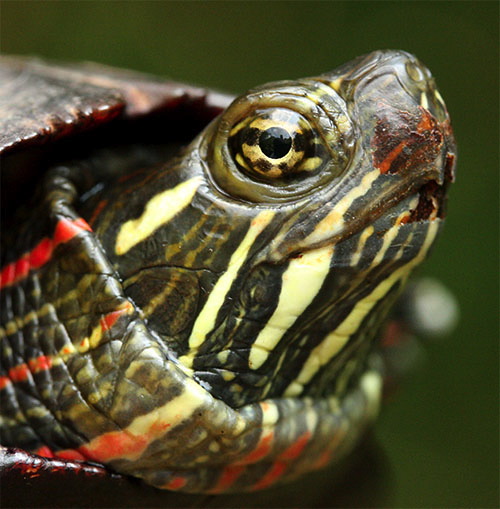
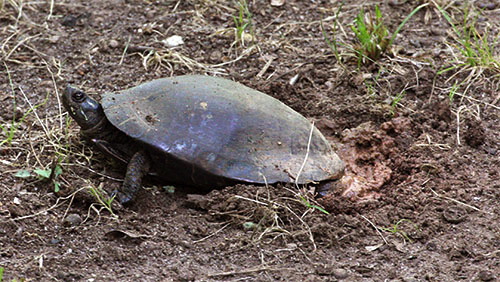
 Only a few small clods of still-moist soil enabled us to find the nest (right).
Only a few small clods of still-moist soil enabled us to find the nest (right).  Last summer, as planned, we removed the wire mesh in late July but decided to cover the nest with an old ten-gallon aquarium (left) that would corral turtlets as they hatched out. From mid-August through October we checked the upside-down tank almost daily and as autumn came and went we were surprised no young turtles emerged. We left the aquarium in place all winter--creating a sort of terrarium in which several weedy plants stayed green even in the snow--and started checking again for hatchlings in mid-March. Nothing transpired, except plants inside the glass grew prolifically in the warm greenhouse temperatures. When we looked under the aquarium this week we noticed two little dark-green disks; amazingly, the Painted Turtle youngsters had emerged at last!
Last summer, as planned, we removed the wire mesh in late July but decided to cover the nest with an old ten-gallon aquarium (left) that would corral turtlets as they hatched out. From mid-August through October we checked the upside-down tank almost daily and as autumn came and went we were surprised no young turtles emerged. We left the aquarium in place all winter--creating a sort of terrarium in which several weedy plants stayed green even in the snow--and started checking again for hatchlings in mid-March. Nothing transpired, except plants inside the glass grew prolifically in the warm greenhouse temperatures. When we looked under the aquarium this week we noticed two little dark-green disks; amazingly, the Painted Turtle youngsters had emerged at last!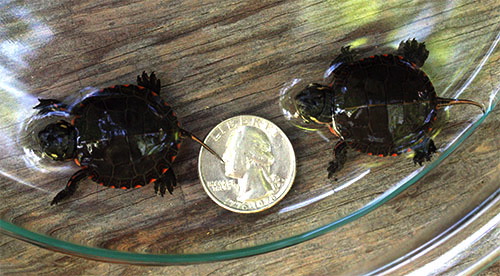
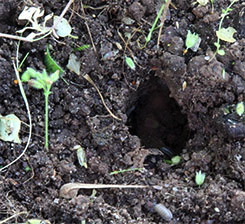 We carefully widened the hole itself, looked within the nest cavity, and were surprised to find no other turtlets or eggs AND no signs of empty eggshells. It seems our Painted Turtle mother had invested a lot of time and energy on a two-egg clutch.
We carefully widened the hole itself, looked within the nest cavity, and were surprised to find no other turtlets or eggs AND no signs of empty eggshells. It seems our Painted Turtle mother had invested a lot of time and energy on a two-egg clutch.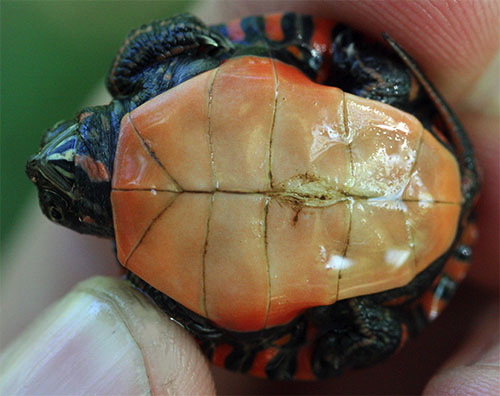

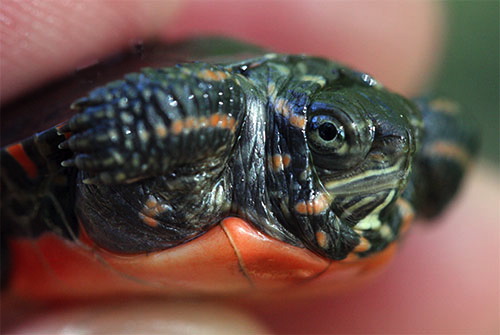



 Please report your
Please report your